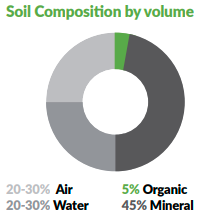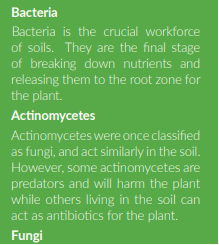Written by George Hepburn from QLF Agronomy
I have worked with farmers on their inputs for the last 15 years. I worked with Soil Fertility Services for 12 years as a Soil Fertility Advisor, advising many farmers on soil health and nutrition. For the last two years I have worked for QLF Agronomy (based in the US), advising farmers on the virtues of using carbon in biological and conventional farming contexts to feed the microbes and fungi which has shown significant yield, quality and fertility improvements. I am FACTs qualified and I have Certificate in Nutrition Farming from NTS. I have seen biological farming go from muck and mystery to main stream agriculture but there is still much more for us to understand about the soil and more importantly the life within it.
Whilst working with quality proven carbon-based products for the past few years I have seen the results of extensive trials and farm use to improve the crops in the US, UK and EU. I believe that future of farming is biological not chemical and over the next 10 years using carbon with inputs will become a standard procedure as the environmental factors alone, such as improved efficiencies and efficacies of fertiliser and fungicide, better conversion of residue to OM and improved breakdown of chemical residues (e.g. glyphosate) are going to push farmers and policy makers down this route. At the moment there is not enough trial work done in this area by the big agronomy companies, although it is increasing as more farmers and agronomists are switching on to the benefits of a biological system.
You have probably heard that there are more organisms in a teaspoon of active soil than there are people on the planet, there is a very complicated world of interactions going on beneath our feet, which even the top soil scientists admit we know little about. We do, however, know the difference that soil biology makes when it starts working for you. Soil structure improves, water is held when needed and released when not, availability of nutrients improves, it can handle traffic much better and it smells like rich dark chocolate!
One Teaspoon of Healthy Soil
• 75,000 Bacterial Species
• Metres of Fungal Hyphae
• Thousands of Protozoa
• Hundreds of Nematodes
• A Few Micro-Arthropods
• Billions of Living Creatures!!
Farmers working on direct drilling systems often notice very quickly how their soil does improve (in a soil sense of time) but many still do not look after the life in the soil enough to get the best out of it. You can now buy different strains of bacillus bacteria and mycorrhizal fungi and apply them directly to your soil, I have sold these products to farmers and they have worked sometimes but not consistently, and this is the problem there are so many variables you don’t know which ones are affecting your soil life.

I am now of the opinion that if you look after the soil, and feed it with the right foods then the soil life will follow without applying any of the actual bugs. There are certain situations that I can understand applying them for example after potatoes when large amounts of chemicals have been applied alongside a major cultivation program, but most of the time what you actually have to do to get these microbes working for you is quite simple.
Ideally you are looking for the target ratio of 45% mineral, 5% OM, 25% air and 25% water. This is the home that the microbes need to not only live but to thrive in. Microbes will respond to feeding by an increase in number, but you will never get to the optimum levels unless they have the correct surroundings. Air and water in the right ratio is key for stimulating the biology. The best way to check this is with a spade and your senses. Dig in a number of places across the field and feel at how well the spade goes in, how far the roots go down, the smell, number of earthworms (and other visible soil life) and how well residue is breaking down. If you want a point of reference go to an old hedge and dig underneath it. This is the potential of your soil.
Science can help too. Calcium and Magnesium help to define the structure of your soil. High magnesium levels can make the soil quite tight and sticky, not allowing air in and holding on to water. High calcium levels can mean the soil is too open and can’t hold on to water or nutrients. Neither of these situations are good for the soil microbes. This is where an in-depth soil test can be useful looking at the exchangeable nutrients and certain key ratios like Ca:Mg, which can guide you down a soil remediation route. When you have the correct soil structure; which I am seeing more frequently as increasing numbers of farmers do less and less tillage, the next job is to feed the soil or more importantly the microbes and fungi. FYM, compost, lime, cover crops, green manures and digestate are good ‘fertilisers’ as they are all giving the soil life a job to do, but to help them to achieve this they need some energy. Plants do with this by exuding simple sugars, fatty acids and enzymes out through the roots to feed the microbes and we can mimic this by applying similar substances to the soil.
Using a carbon-based (read sugar) product like L-CFB BOOST™ as part of your system can make a big difference, not only are there various types of sugar (sucrose, fructose, glucose and more) which is ideal for feeding the bacteria there is also a more complex food added for both microbes the fungi. Using this type of product alongside your regular applications means that every time you go through the crop you are looking after and feeding these microbes and helping them to perform their role. Do be aware that there are many types of these carbon products getting on the market going from raw beet molasses through to humic acids. Some of these are not suitable for this type of application and a lack of consistent trial data over the years puts a question mark over their benefits. Make sure you ask for independent and farm trial data and look for a good track record of results and ideally farmers that are using it that you can actually talk to.
Getting your soil microbes working for you can mean reduced inputs of fertiliser and fungicides, OM levels building, less run off and erosion, better water holding capacity, improved rooting, better residue breakdown and increased nutrient cycling. All you have to do is give them a stable home and feed them with a quality product little and often.


